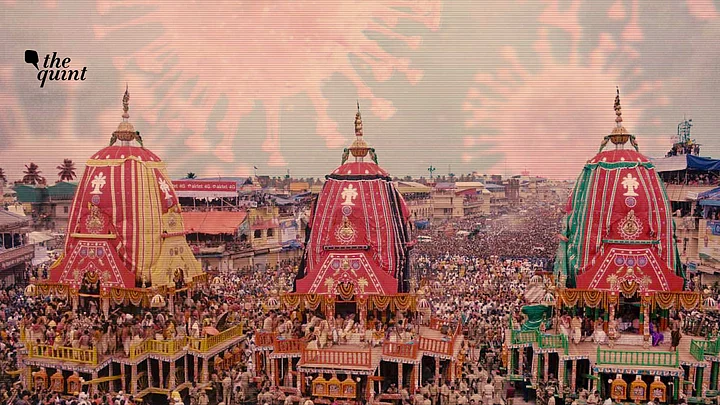A huge question mark stares at the world famous Rath Yatra of Puri as the growing menace of COVID-19 has spread its tentacles in more than eleven districts across Odisha, including the holy city.
A situation which, on Monday, 8 June, forced the government to re-enforce strict regulations till 30 June, including complete weekend shutdowns on Saturdays and Sundays.
And Puri is no exception.
Amid Mounting Pressure, Temple Management Tries to Strike 'Balance'
Construction of the three huge chariots are on at a war footing and, simultaneously, preparedness for the Lord Jagannath’s ‘Snan Yatra’ (or bathing ceremony, which is a precursor to the yatra) is also underway.
Amid this confusion and fear of the pandemic, however, pressure is being mounted on the government for the Rath Yatra to be held, no matter what, in order to keep up traditions.
The fresh guidelines prohibit any kind of congregation inside religious places. However, it is know that the Rath Yatra usually sees the congregation of massive crowds to pull the chariot.
Now, to balance between social distancing and religious virtuosity, the temple management has planned an alternative.
It has been decided that, only the servitors of the temple shall bring the deities on to the chariots which is known as ‘pahandi’ (ceremonial procession).
But that requires about 150 people (servitors), and social distancing is almost impossible.
The Puri administration has plans to impose Section 144 during all events like 'Snan Yatra' and subsequently during the Rath Yatra itself, in order to stop any entry into the city from all sides.
If Rath Yatra Goes as Planned, Social Distancing is Impossible
So, when any religious congregation at this juncture is not viewed to be healthy, plans are afoot for the security forces, including the police and paramilitary, to be engaged in pulling the three chariots from the main temple to Sri Gundicha temple, three kilometres away, where the deities sojourn for nine days.
After this, they come back to the temple with equal fervor, in a ceremony known as the ‘Bahuda Yatra’ (return festival).
Interestingly, for pulling the three chariots, a minimum of four to five thousand security forces are required. This is an hours-long exercise, with an average of one thousand-plus people clutching each rope. In such a situation, and with the mercury rising to 40 degree celsius, the idea of social distancing or physical distancing can only be mocked at.
When such huge numbers blister through the 3-km long road, all such virtues will lose their pertinence.
The chief administrator of the temple tried to defend the plans for the Rath Yatra by saying that each of the servitors and security personnel engaged in the festival will have to go through a COVID-19 test “because social distancing during the 'pahandi', is not at all possible".
Government Must Play a Balancing Act
Can that, however, be a foolproof guarantee of the well-being of the security forces as the administration plans to deploy them for the chariot-pulling on the pretext of official duty?
Although the seer of Puri, Swami Nischalananda Saraswati, still remains noncommittal on the commencement of the Yatra, he has endorsed that the rituals of the deities for the ‘Snan Yatra’ be performed within permissible limits.
Hearing a PIL on holding the Yatra in Puri, on Tuesday, 9 June, the Orissa High Court said that it doesn't want to interfere on the matter and left it to the state government and the Centre to chart out the modalities on how the festival can be held as per guidelines.
So, now, the ball is in the state government’s court to decide how safe it will be to go ahead with the festival with just 13 days to go, and the menace of COVID-19 showing no sign of any let up in Odisha.
The King of Puri, Divya Singh Deb, appears to be playing a mediating role between the servitors and the government. It is also evident that he doesn’t want to irritate either side.
Pressure is building on the government from all sides to choose the challenge of holding the Yatra or to dispense with the ritual for a greater cause, given that it is a health risk for many.
If the congregation of people at the Tablighi Jamaat could prove to be a disaster, then wisdom must in this case as well. Especially as the entire state is on red alert and there is a prevailing climate of fear.
The government and temple management must read into the realities of the situation in the state and act in accordance.
(Dinendra Narayan Singh is a Bhubaneswar-based senior journalist and political analyst. This is an opinion piece and the views expressed are the author’s own. The Quint neither endorses nor is responsible for them.)
